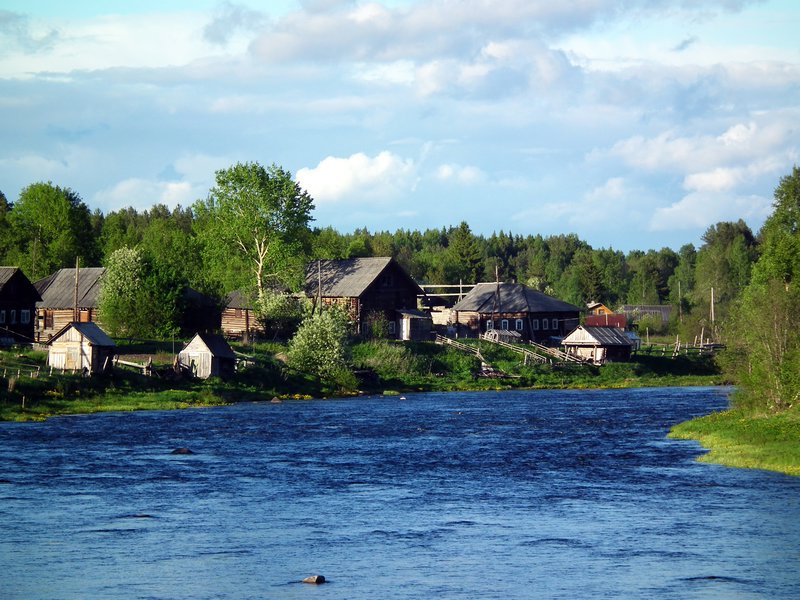Karelia
Karelia, some twenty hours north of Moscow by train, is renowned for its natural beauty, wildlife and pretty wooden villages and churches. Bears, wolverines, martens and eagles are among some of the species to be found wandering Karelia’s endless forest, hills and lake shores.
Karelia’s most famous and tourist-overrun attraction is the museum of wooden architecture on the island of Kizhi. Examples of wooden architecture were brought here from all over Russia during the USSR and it is undoubtedly spectacular. However, of more interest to me is the fact that in many Karelian villages elsewhere the very architecture on display to tourists at Kizhi is still in everyday use in the form of (admittedly slightly less spectacular) log cabin churches and 19th-century log homes dotted all over the republic and neighbouring Arkhangelsk Oblast.
Simply by traveling from north to south down Lake Onega’s western shore you can take in a series of working log churches dating back even to the 15th Century. While not quite as spectacular as the oft-photographed one at Kizhi they are still absolutely stunning and to my mind far more interesting because they are still in use today as places of worship. Some even have onion domes almost rivaling those at Kizhi and bell towers all made of logs. Remoter villages rarely get priests sent out to them and the inhabitants have to make do, holding services themselves.
The eastern shore also has some fine examples of log architecture dating back centuries although churches tend to be smaller and less ornate than on the western shore.
Whereas the northern part of the western shore has the area’s three main train stations, the south-western shore and whole eastern shore have no railways and very few buses. There is a road leading from Pudozh on the eastern shore into Arkhangelsk Oblast where ancient log churches and beautiful wooden architecture in general abound.
Some examples of good places to see beautiful log churches around Lake Onega include:
*Rodionovo, Gimreka and Shchelyeyki near the south-western shore. They are all best reached on your own transport. Buses from Petrozavodsk, Karelia’s capital, run three times a week to Gimreka and Shchelyeyki, which are 5km apart. the bus’s final destination is Voznesenye or Vyterga. There are also daily buses from Petrozavodsk to Kaskesruchey from where it’s a 10km walk to Gimreka and another 5km to Shchelyeyki. The whole route is much more easily done with your own transport or by hitch hiking. Be warned that roads are just dirt and full of potholes.
From Shchelyeyki to rodionovo you need to go to Voznesenye, a village laid out on two banks of the River Svir but with no bridge connecting the two halves. As long as the wind is not too strong a ferry takes cars across once every hour. To the left of the place where cars wait for the ferry houses are spread out along the bank and locals have rowing boats they use to cross the river. If the wind seems strong and lots of cars have been waiting for the ferry for the long time, try asking locals to take you across in their boats.
From Voznesenye three buses a week go to a town called Podporozhye which has daily trains to Moscow, Petrozavodsk and St Petersburg. Rodionovo is about a third of the way from Voznesenye to Podporozhye and about 2km to the right off the main road.
Traveling from Podporozhye to Petrozavodsk there is also a stunning church at Manga, about 15km off the main road to the left about two thirds of the way to Petrozavodsk. Daily buses run between Podporozhye and Petrozavodsk but as with everywhere in this area, if you want to actually get off buses and see more than one place on a trip then your own transport or hitch hiking is essential.
Rodionovo’s church is one of the oldest wooden buildings in Russia, dating from 1493. Shchelyeyki’s is one of the most beautiful, with multiple wooden cupolas, a log bell tower and a log tunnel connecting the bell tower to the church.
Voznesenye has a very basic hostel (hole in floor toilet, buckets of water instead of showers) for 200 rubles a night (2011). The address is Vodnikov Pereulok 21. Podporozhye and Petrozavodsk also of course have hotels.
Traveling around the southern end to the eastern shore, Paltoge also has a beautiful log church.
Pyalma (three quarters of the way up the eastern shore) and Chyolmuzhi (halfway between Medvezhegorsk and Pyalma) have beautiful but more modest churches. Both are accessible by infrequent buses betwen Petrozavodsk and Pudozh.
This is VERY FAR from being an exhaustive list. With some time and preferably your own transport you can find some serious hidden gems in this region that have rarely been visited by foreigners, so overshadowed are they all by Kizhi. In each village there is someone who keeps the keys to the church. If you want to look inside, ask around to find out who has the keys and they should be happy to open it up for you.
The three main access points to Lake Onega are Petrozavodsk (the capital of Karelia), Kondopoga (which also has a beautiful log church nearby) and Medvezhegorsk on the northern shore. All three have daily trains south to Moscow and St Petersburg and north to Murmansk and the Kola Peninsula.
Be warned – in summer in the Karelian countryside you will never stop getting devoured by mosquitoes. It’s worse than anything I’ve experienced deep in the jungles of the Amazon or West Papua, but nowhere near as bad as Russia‘s Nenets Autonomous Okrug. Local shops sell hats with a mosquito net hanging down to protect your face.
Click here for my blog about the Eastern shore of Lake Onega. It’s 3932 words and 15 photos.
Click here for my blog about the Western shore of Lake Onega. It’s 4438 words and 10 photos.

Leave a Reply